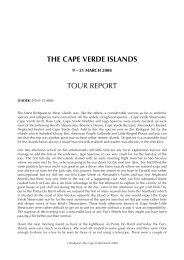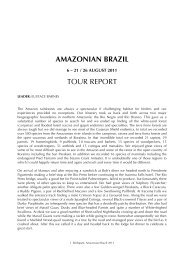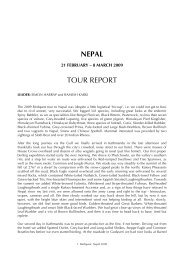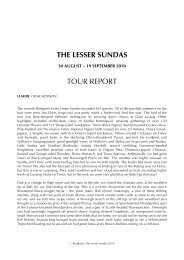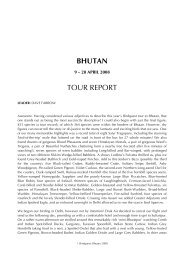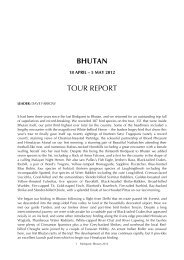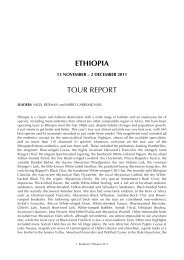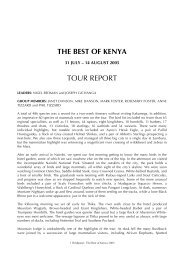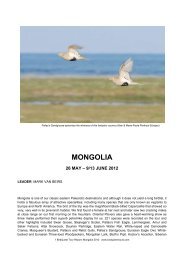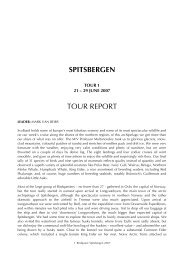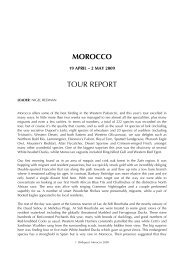Download Full Tour Report 1202kb - Birdquest
Download Full Tour Report 1202kb - Birdquest
Download Full Tour Report 1202kb - Birdquest
You also want an ePaper? Increase the reach of your titles
YUMPU automatically turns print PDFs into web optimized ePapers that Google loves.
Fine-barred Piculet (Marcapata P) Picumnus subtilis: We had to wait, but eventually we were<br />
rewarded with good views of a male at Amazonía Lodge.<br />
Yellow-tufted Woodpecker Melanerpes cruentatus: Oddly just two sightings of this red-bellied<br />
species, the only representative of the genus in the Amazon basin.<br />
Little Woodpecker Veniliornis passerinus: One sighting from secondary woodland at Amazonía<br />
Lodge.<br />
Red-stained Woodpecker Veniliornis affinis: We enjoyed excellent scope views of a bird<br />
accompanying a mixed flock at Manu Wildlife Centre.<br />
White-throated Woodpecker Piculus leucolaemus (H): Heard twice in the Manu lowlands but always<br />
unresponsive.<br />
Golden-green Woodpecker Piculus chrysochloros: One individual was seen pretty well in the same<br />
flock as the previous species at Manu Wildlife Centre.<br />
Golden-olive Woodpecker Piculus rubiginosus: We had a good sighting of a pair from the Cosñipata<br />
valley near Cock-of-the-Rock Lodge.<br />
Crimson-mantled Woodpecker Colaptes rivolii: We were treated to a really nice view of this<br />
handsome woodpecker en route to the Acjanacu pass on our second day.<br />
Spot-breasted Woodpecker (S-b Flicker) Colaptes punctigula: A real crowd-pleaser as soon as we<br />
stepped off the bus to bird the Puerto Maldonado environs.<br />
Andean Flicker Colaptes rupicola: We first saw two individuals at Laguna Huacarpay and two more<br />
were seen during the journey to Pillahuata. This woodpecker is restricted to the arid puna<br />
zone from Northern Peru to Northern Chile and northwest Argentina. Here we saw the<br />
race puno.<br />
Scale-breasted Woodpecker (Scaly-b W) Celeus grammicus: Two separate sightings, the first from<br />
one of our full days at Romero Lodge and we later saw two on the Manu Wildlife Centre<br />
trails.<br />
Cream-coloured Woodpecker Celeus flavus: One of the most distinctive of the genus, a male was<br />
seen well during one of our walks to the Romero Lodge.<br />
Rufous-headed Woodpecker Celeus spectabilis: At Pantiacolla a bird perched out at the edge of the<br />
trail giving a few of us brilliant views whilst others did not fare so well.<br />
Lineated Woodpecker Dryocopus lineatus: Several sightings from Amazonía, Romero and the Cocha<br />
Camungo tower. A relative of the Pileated Woodpecker D. pileatus of North America,<br />
and the Black Woodpecker D. martius in Europe.<br />
Red-necked Woodpecker Campephilus rubricollis: A single was first seen briefly at Romero but we<br />
followed this up with a really good sighting at the Antthrush trail on our last day at Manu.<br />
Crimson-crested Woodpecker Campephilus melanoleucus: A total of 8 seen. In southeast Peru, most<br />
often found in riverine forest and floodplain forest bordering oxbow lakes.<br />
FURNARIIDAE<br />
Black-tailed Leaftosser (B-t Leafscraper) Sclerurus caudacutus (H): At Manu Wildlife Centre we had a<br />
bird call from quite close one evening but strangely it gave no response.<br />
Coastal Miner Geositta peruviana: Excellent views of this endemic in the desert north of Lima.<br />
Miners are so called because of their habit of nesting in holes dug in the ground (like<br />
earthcreepers). A bit reminiscent of a small lark and filling a comparable niche.<br />
Slender-billed Miner Geositta tenuirostris: We had excellent views of a vocalising bird in the Cusco<br />
highlands en route to Manu.<br />
Greyish Miner Geositta maritima: At Lomas de Lachay we saw several singles and then a group of at<br />
least 4 foraging together on the barren, stony slopes.<br />
Thick-billed Miner Geositta crassirostris: We had very good scope views of this speciality at Lomas<br />
de Lachay, a restricted-range Peruvian endemic.<br />
Cream-winged Cinclodes Cinclodes albiventris: Good studies of two birds during our journey<br />
through the highlands on the second day. The albiventris group of Peru, Bolivia, northern<br />
Chile and northwest Argentina as well as the albidiventris group (Chestnut-winged<br />
Cinclodes) of the northern Andes were recently given full species status by the SACC.<br />
24 <strong>Birdquest</strong>: The Manu 20011




